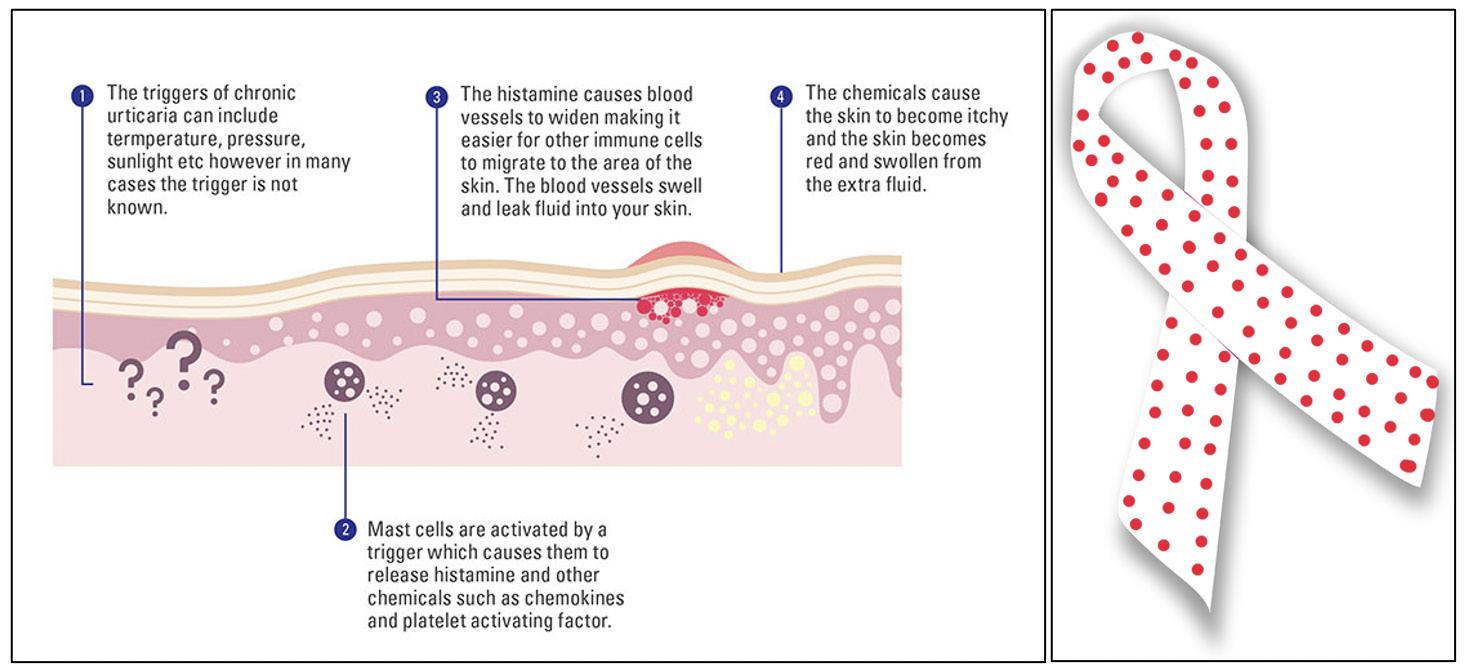Pathophysiology, Diagnosis, and Treatment of Heat-Induced Hives: Cholinergic Urticaria BY TYLER CHEN '24 Cover Image: On the left is the general immune response that leads to wheal formation – the characteristic symptom of chronic urticaria. With cholinergic urticaria, increases in body temperature lead to this immune response through multiple mechanisms. On the right is the ribbon for chronic urticaria awareness. Image Source: Wikimedia Commons
Introduction There are not many conditions that are both as commonplace yet largely unheard of as cholinergic urticaria (CU). In fact, it wasn’t until 1924 when CU – referred to as “urticaria calorica” at the time – was first documented by Duke (Duke, 1924). In essence, CU is the abnormal sensitivity to heat. Those afflicted with CU will produce numerous small (usually <5mm in diameter) short-lived pruritic wheals (itchy hives) – most frequently on the upper trunk and proximal limbs – when the body’s core temperature rises from some sort of heat stimulus (examples include physical or mental exertion, eating spicy foods, and taking hot showers) (Kim et. al, 2014). The symptoms subside quite quickly – typically within an hour or so – after the core body temperature lowers. But, even then, it may significantly impair quality of life, especially for athletes whose body temperatures frequently elevate due to routine physical exertion through their sports. Due to its characteristic clinical presentations, diagnosis of CU has become quite easy. However, the underlying pathophysiology behind CU still remains uncertain. Clinically, we can categorize CU into 4
55
subcategories: 1) CU with Poral Occlusion (CuPO), 2) CU with Acquired, Generalized Hypohidrosis (CuAGH), 3) CU with Sweat Hypersensitivity (CuSH), and 4) idiopathic CU (iCu) – all of which are further detailed over the course of the paper. These four subtypes all have unique presentations and underlying pathophysiologies that lead to the urticarial reaction. In all cases, CU can be generally diagnosed fairly easily through either an exercise test or some other heat stimulus (Commens & Greaves, 1978). However, further distinguishing between the four types for CU requires additional diagnostic tools. Moreover, due to the varying pathophysiologies behind all four conditions, treatments for each are distinct as well, necessitating the precise diagnosis of the specific type of CU. The disease itself is fairly common across the general population, with most cases being seen among young adults. Different studies have aimed to determine the prevalence of CU among the young adult population, but there is no consensus on the real figure. For example, a study on university and high school students in Germany found that 11.2% of the young adult population displayed whealing consistent with DARTMOUTH UNDERGRADUATE JOURNAL OF SCIENCE











